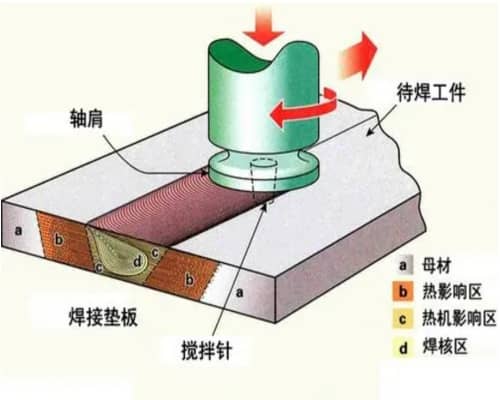La soldadura por fricción, también conocida como FSW, es una nueva tecnología de conexión en fase sólida inventada por el Instituto Americano de Soldadura en 1991 bajo la acción combinada de la fuerza mecánica y el calor por fricción. Aunque esta tecnología empezó tarde, rápidamente llamó la atención de los principales fabricantes por su excelente protección medioambiental y su capacidad de soldadura.
En el proceso de FSW, un cabezal agitador cilíndrico con un hombro de eje especial y un saliente de aguja girará y se introducirá lentamente en la pieza a soldar. Mediante una intensa agitación, fricción y presión, el material metálico de la soldadura se ablandará plásticamente. Cuando el cabezal agitador gira y se mueve hacia adelante, el material metálico termoplástico se transferirá desde la parte delantera del cabezal agitador a la parte trasera, y será frotado y forjado bajo la acción del hombro del eje agitador, y finalmente se convierte en una junta de tejido forjado fino. Aprovecha al máximo el calor de fricción y evita la drmación severa del material metálico calentado por medio de la presión, y "une" rápidamente dos piezas de metal, combina ingeniosamente los métodos de calentamiento y prensado.、

搅拌摩擦焊_500
Actualmente, puede utilizarse en la fabricación de una gran variedad de piezas de automóvil, como cubos de rueda, ejes traseros, bandejas de batería de aleación de aluminio, revestimientos de cárter de motor, refuerzos de revestimiento lateral, piezas estructurales de refuerzo de puertas, unión de piezas de extrusión de gran tamaño, etc.
Ford, BMW, Fiat, GM, Mercedes-Benz y Volvo han participado en la fabricación de estos componentes. Pero esta tecnología es desarrollada principalmente de forma independiente por los proveedores, o conjuntamente por proveedores y empresas automovilísticas como su ámbito de uso. En términos de reservas técnicas, los proveedores siguen siendo dominantes.
Como todos sabemos, las aleaciones ligeras como las aleaciones de aluminio y magnesio tienen desventajas de reblandecimiento severo de la unión, fácil formación de película de óxido, generación de poros y grietas térmicas y graves deformaciones durante la soldadura- FSW puede resolver exactamente este tipo de problemas. Ya en 2005, se utilizó en el Ford GT 2005 para soldar aleaciones de magnesio y aluminio. Puede decirse que la soldadura por fricción es uno de los procesos de soldadura más adecuados para los materiales de aleación de aluminio.
1. Ventajas del FSW
Para reducir el peso del vehículo al tiempo que se garantiza la rigidez, a menudo se añaden elementos de refuerzo (como el Mg) a las aleaciones de aluminio. Debido a la elevada temperatura de soldadura por arco de la soldadura láser, los elementos de refuerzo se queman con facilidad, la resistencia del cordón de soldadura y el rendimiento del vehículo se verán afectados, mientras que la soldadura por fricción con una temperatura de soldadura más baja no tiene este problema. El proceso de soldadura láser es difícil, y la calidad es propensa a la repetición.
2. El espacio de mejora de la soldadura por fricción
FSW no es un método de soldadura absolutamente perfecto. Por ejemplo, la velocidad es un gran problema. En general, la velocidad de este método de soldadura es de unos 100 mm/min, mientras que la velocidad de la soldadura láser, que también puede realizar soldaduras continuas, es de unos 3000 mm/min.
Por mencionar los últimos avances, lo más emocionante son las últimas investigaciones del Pacific Northwest National Laboratory (PNNL) del Departamento de Energía. Gracias a la cooperación con General Motors, Alcoa y Timken (TWB), la velocidad de FSW se ha multiplicado hasta por 10, lo que ha reducido enormemente el tiempo y el coste de producción y, al mismo tiempo, se han obtenido piezas más ligeras y resistentes. Según los informes, el proceso mejorado puede reducir el peso de la puerta en 62%, mientras que el coste puede reducirse en 25%.
3. Conclusión
En este momento, FSW es todavía una tecnología emergente, la tasa de penetración no es muy alta. Sin embargo, como el peso ligero se ha convertido en un consenso, los materiales de aleación de aluminio y magnesio han recibido una atención sin precedentes, lo que inevitablemente conducirá a la aparición repentina de la tecnología de soldadura por fricción.
Además, con la creciente concienciación sobre la protección del medio ambiente, las tecnologías ecológicas de fabricación de coches, como los revestimientos al agua, los procesos intermedios de revestimiento y la soldadura por fricción, irán sustituyendo gradualmente a la soldadura por láser, la inyección de cera en cavidades y la pintura gruesa para coches, etc. Una nueva ola tecnológica.
De: http://www.essebinet.com/